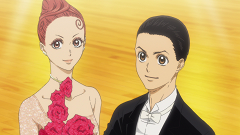This is going to be a loose, informal series of takes on the last four episodes of Ballroom e Youkoso. We’re saving the professionalism for the series review post. If you think this show is the best thing since sliced bread, or just a competent anime series that you happen to enjoy, you’ll want to avert your eyes.
21: I recently had a conversation with my brother about whether art can be objectively labeled “good” or “bad.” Take anime, for example. Show the same episode to 100 different people, and you’ll get 100 varying ideas about how “good” it was. There’s no perfect metric that can be used to determine the quality of an artistic work – or so I thought, until I watched this episode. It is now my belief that you can fairly and impartially measure how bad an anime is by the length of its flashbacks and digressions. This episode was full of them, and it all started with a two-and-a-half minute free association exercise by our resident rival character, Hyodo Kiyoharu. We got scenes of him grilling his mom about her coaching technique, his opinions on the strengths of different dance partners, and a breakdown of stretches that can increase mobility, all in the middle of Tatara’s performance. This was just the beginning, as the show proceeded to bring Shizuku, Mako, Gaju, and a couple of sideline reporters in on the fun. No amount of metaphorical door kicks could save this episode from distracting itself to death.
22: This episode began with a flashback, but it was self-contained and only lasted for half the episode, so at least it wasn’t disruptive to the point of awfulness. It was Kugimiya’s turn in the spotlight this week, although “spotlight” might not be the best word for it, given the bleak treatment his character received. Production I.G. has chosen to cut one of the brighter aspects of his story: a relationship with a pair of boisterous nephews who support him from the stands. Ordinarily I wouldn’t complain about a reduction in the show’s massive peanut gallery, but this particular omission leaves us with a terribly dark portrayal of Kugimiya. The guy literally wishes for death midway through his dancing career, and upon being hit by a truck, thinks to himself, “There is a god.” Then he wakes up in the hospital, cursing his revival, and has to watch as his former coach breaks down and insists that he study under someone better. There’s plenty more sad stuff in his backstory, but those were the highlights we got before Ballroom reverted to bullshit mode and had Hyodo ruminate on the nature of partnership for eleven more minutes.
23: We’ve entered anime-original territory here. Some of these events were covered by the manga, but the focus on Idogawa (or “Banshee,” as Kugimiya calls her) was totally new. As far as I remember, the metaphor of Chinatsu emerging from an egg in Tatara’s chest is original, as well. What were we supposed to take from that scene, I wonder? That Chinatsu has found a place in his heart, or that he had the capability to understand her all along? It’s a cool-looking scene, but it didn’t make me feel one way or another about the couple. That’s the big issue that I’m having with Ballroom at this late stage – none of Tatara’s triumphs feel earned. It was great to watch him jump for joy when Sengoku called his cell, but if a phone conversation and some cooperation from Chinatsu were all it took for him to power up, it could have happened at any moment. It feels less like a culmination and more like a coincidence. I’ve got other gripes with this episode, but it was mostly decent (with some snazzy dance scenes as an added bonus), so let’s watch the finale and see how it lands.
24: For all my criticizing and nitpicking, I did get swept up in the drama of this episode. Even as I took sarcastic notes about Hyodo’s role as an all-seeing mouthpiece or Tatara’s impossible improvement over the course of a year, I was pulling for the kid to win. And win he did – not just the trophy, but a peck on the cheek, too! With a first place finish under their belt, he and Chinatsu will be partnered for the foreseeable future, and that’s cause for celebration, since they seem to be on the same page all of a sudden. Tatara describes an ability to “love himself and hate himself” when he’s with her, and although that phrase is only half encouraging on its face, the message of emotional openness it conveys is a positive one, I think. During his final dance, the show gave us a glimpse of Tatara’s mom leaving their house, suitcase in tow, for what we can assume was the last time. My guess is that there’s an expressive, traditionally “feminine” part of him that was sealed off when his mother disappeared from his life, and that dance is a way he connects with that aspect of himself. Assuming the manga continues publication, it’ll be a while before we learn whether that theory holds water. In the meantime, I’m happy that Tatara has reached a point where he’s successful and content. After all, isn’t that what life is all about?
Final series review coming soon.





The series is surprisingly close to reality on multiple ballroom related topics but the whole idea of “experience doesn’t matter in ballroom”is unfortunately kinda bogus. I understand that they needed to make it interesting and there’s no way to do that without Tatara being able to catch up but no matter how hard you work or how talented you are it’s just really unlikely you can win in an A-class comp after such a small amount of time.
If the main hero was a follower it’d be at least somewhat possible but training to be a leader takes a really long time.
It’s shown that Tatara trains hard but it’s hard to judge how much exactly. Just for reference a competitive level couple dancing at a high level trains about 8 hours per day.
So it’s a bit strange to see how accurate e.g. Hyodo is to a real life dancer while Tatara is getting deus ex treatment all the time. Oh well, it’s anime after all and I don’t think it’s directed towards real life ballroom dancers per se.
P.S. 15 is really old to start ballroom as well, not sure how It is in Japan but at least in Russia which pretty much produces some of the best ballroom dancers in the world you need to start around 6 and it takes at least 10 years to get to a serious-ish level.
Yeah, it was discouraging to hear Hyodo handwave Tatara’s victory with, “That’s just how dance is sometimes.” The show began fairly promisingly in that regard, with Sengoku taking offense at the nerve of some teenage brat who decided to pursue professional dance on a whim. Shounen formula always wins in the end, I guess.
Are you a dancer yourself, or do you just follow the scene? In either case, what do you make of Tatara’s “four-legged feeling”? His struggle with that sensation never clicked with me as a viewer, so I’m hoping it’s just something that a dance layman like myself can’t understand.
I am similar to Tatara in that I started training at 16 myself and been involved in dance ever since for 15 years. That also means I know firsthand what real dancers think about late starters and Sengoku was spot on in that regard, although mostly it’s not anger, it’s deep understanding on how much work it actually takes to become good. World-class ballroom dancers are among the most hard-working people in the world so working harder than them to advance faster is pretty far-fetched.
I find “four-legged” feeling a shounen exaggeration most of all to somehow justify the advances which should normally take years. It is somewhat based in reality as the connection between partners is feeling each other’s weight when the connection is working but it’s a very small fraction of the total. Overall, the main principle it shouldn’t be heavy, the follower is dancing on her own legs, the impulse is only transferred through the lead when the leader wants the follower to change direction, he’s not carrying her around like the show seems to imply. Followers get pretty pissed off actually at heavy-handed lead as it’s really hard to keep balance when you are being pushed around.
Thanks a lot for the responses! I wish you good luck in your continued dance endeavors.
This is what I wanted to know the whole time.